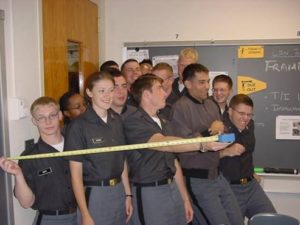Model Description
This model will get your students on their feet during class and help them visualize the concept of distributed loading. This demonstration should take 5-7 minutes.
Engineering Principle
In order to get students to begin to get a feel for load transfer and modeling loading, it is helpful to show an example. This exercise demonstrates the equation for a distributed load.
(in units of lbf/ft2)
What You Need
| Item | Quantity | Description/Clarification |
|---|---|---|
| Tape Measure | 1 | This is used to measure the area the students will occupy. $15 |
How It’s Done
Before Class: None.
In Class:
The International Building Code (IBC) and other design codes specify various numbers for distributed loads for design. For students that are new to engineering classes, these numbers may appear a bit arbitrary. Show various codes and planning factors from textbooks for distributed loads and ask where these numbers might have come from. Answers will vary, but with proper questioning, we quickly can arrive at the above equation. Then, ask students how they would like to test the accuracy of the numbers in the code. Agree upon a fixed weight per student and multiply that by the number of students in the class and try to decide upon an area to divide by. This leads into some interesting discussions, but again with some guidance, students will get the fact that we want to consider the worst case, which is having the class try to get into as small an area as possible, which the instructor then measures (see Figure).
CAUTION: You may have some students in class that are shy and don’t enjoy being in extremely close proximity with others, so you can provide the guidance to occupy one tile square or get as close as possible without touching. Usually, the numbers calculated based on this exercise exceed the code recommendations by a large amount. At this point, discuss why the code factors are lower and talk about things like Factors of Safety on loading conditions.

